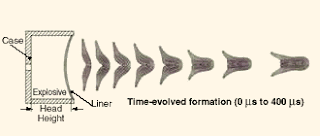Update July 12th The commentator Trazzer has made a very strong argument for the items shown below being standard shaped charged rather than EFPs in the comments below this article, worth checking them out.
Stratfor recently reported on claims by the Hawks Brigade of the Levant that they are now using a type of IED known as an explosively formed penetrator (EFP). EFPs have a long history of use in a number of conflicts, and most recently have been used in Iraq to attack coaltion armoured vehicles.
Stratfor recently reported on claims by the Hawks Brigade of the Levant that they are now using a type of IED known as an explosively formed penetrator (EFP). EFPs have a long history of use in a number of conflicts, and most recently have been used in Iraq to attack coaltion armoured vehicles.
An EFP consists of a copper tube filled with explosives, with a concave copper liner over the end of the pipe, faced towards the target. The copper tube prevents fragmentation during the explosion, and the concave copper liner focuses the blast in such a way to penetrate the armour of the target. The below picture shows an example from Iraq:
The below diagram and animation shows how the copper liner turns into a projectile that can penetrate armour:
The following video from Deir ez-Zor in the east of Syria, near Iraq, shows EFPs now being used to construct IEDs, and is the first video evidence confirming their use in Syria:
It does seem likely that the FSA have acquired the skills to build these IEDs from insurgents in Iraq, and it confirms that Assad’s armoured vehicles are at least as vulnerable to IEDs in their outdated Russian armoured vehicles as US forces are in their more sophisticated armoured vehicles in Iraq. Update July 4th This video has been posted which shows how bombs can be created from artillery shells
At 2:50 he takes out what appears to be an IED with a inverted cone liner. @alhazrid informs me the man in the video describes the IED as directed, and it has a cone, but doesn't mention what it's made from. Another interesting point for fans of irony, both the US and UK accused the Iranian government of providing Iraqi insurgents with the information and equipment required to build shaped charges as described above, so if true it would be rather ironic if that information has gone from Iraq to Syria so the FSA can fight Iran's close ally.
You can contact the author on Twitter @brown_moses or by email at brownmoses@gmail.com



Huh. Imagine that. Guess the al Quds forces aren't the only ones who know how to spread deadly, ingenious and cheap guerrilla tactics around. That EFP's deployed against US troops in Iraq were Persian in origin is a well proven fact. Not sure who is providing them to the FSA in Syria, but as the Youtube video shows, this "technology" is now "open source." Considering how many foreign fighters against US troops in Iraq got safe passage through Syria, it is ironic how the hand that feeds often gets bit.
ReplyDeleteThat first video shows components for shaped-charges, not EFP
ReplyDeleteThe second video also shows a shaped-charge, rather than an EFP. It doesn't matter what material the cone is made from because it is the shape of the main charge which causes the shaped-charge effect. The stand-off requirements for a shaped-charge are also quite complicated; something that training is required for. Whereas an EFP can be deployed completely differently.
ReplyDeleteThis comment has been removed by the author.
ReplyDeleteIf you have any examples of EFPs that would be very handy.
ReplyDeleteThe footage tends to get taken down quite quickly. Keep an eye on the Kateib Ahrar al-Sham Youtube channel. The videos aren't advertised as EFP but the indicator is a shallow metallic liner at the front of a cylinder which is placed at the side of a road. There is a video doing the rounds which claims to show the death of Colonel Abdul Razak el-Khalaf caused by an EFP IED; there is footage of the device.
ReplyDeleteThe BBC had a good feature of Syrian militants which shows the emplacement of an IED which is highly likely an EFP. I say this because of the shape of the IED container and the way it is deployed, even though the front of the IED and a liner cannot be seen:
http://www.bbc.co.uk/news/world-18580175
Rule of thumb: if the cone in an IED is steep, it is a shaped charge; if it is shallow, it is more likely to be an EFP liner.